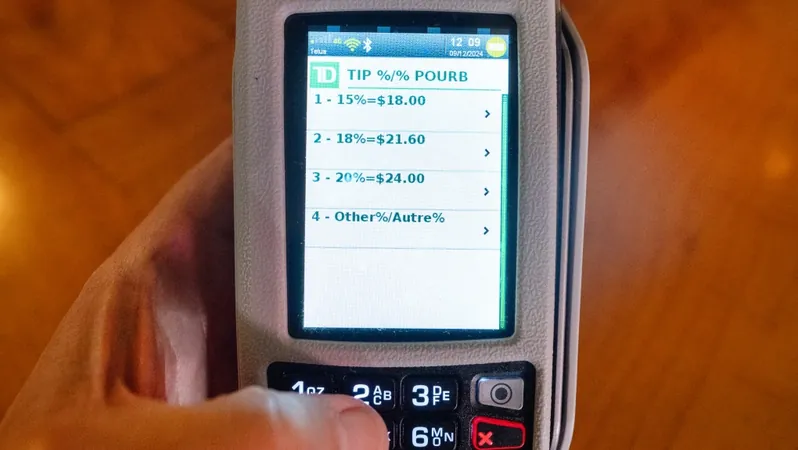
Your Ultimate Tipping Guide for Canada: The Unwritten Rules You Need to Know!
2025-01-09
Author: Charlotte
Navigating the complexities of tipping in Canada can be quite a challenge, especially for newcomers and tourists from places where tipping isn’t customary. With unique social norms and varying expectations, understanding when, where, and how much to tip can feel overwhelming. Fear not! Here’s your ultimate guide to mastering Canada’s tipping culture.
In Canada, much like in the U.S., tipping is a common practice. It's typical to tip service workers in various settings, primarily at sit-down restaurants, bars, and for food delivery services. Interestingly, you might encounter prompts to tip even in places like convenience stores and jewelry shops, where tipping isn’t usually expected.
Why Does Tipping Matter?
According to Mike von Massow, a food economist from the University of Guelph, tipping acts as a social norm rather than a legal obligation. “The strongest social norm is tipping in sit-down restaurants. Where to tip beyond that has become much broader in recent years, particularly with new payment technologies,” he explains.
Countries such as France and Japan operate under different paradigms where workers often don’t count on tips to supplement their income. This cultural difference further emphasizes the peculiarities of the Canadian tipping landscape.
The Tipping Breakdown: What You Need to Know
1. **Restaurants:** - **Expected:** 15–20% of the pre-tax bill. A top-notch experience may warrant a more generous tip of 18–25%.
2. **Bars:** - **Expected:** Around $1 per drink, or 10–20% on the total tab. For food service at bars, follow the restaurant tipping guidelines.
3. **Takeout:** - **Appreciated:** Tips are not required but leaving small change or around 10–15% is a nice gesture.
4. **Food Delivery:** - **Expected:** A minimum tip of 10%, generally around $5. More is appreciated for larger orders or during inclement weather.
5. **Cafés and Bakeries:** - **Appreciated:** Leaving your change or about 10% is a kind reflection of good service, particularly for complex orders or if you’re a regular.
6. **Taxis and Rideshares:** - **Expected:** About 10–15%. If paying with cash, rounding up to the nearest $5 is a good rule.
7. **Tour Guides and Hotel Staff:** - **Appreciated:** A tip of $5 for a tour guide and a couple of dollars per bag for bellhops is customary. Housekeepers can receive $2–$5 daily.
8. **Beauty and Wellness Services:** - **Expected:** Tipping around 15% is standard for hairstylists and estheticians, but no tip is required for medical massages.
Should You Feel Pressured to Tip?
With the rising trend of tip prompts appearing in unconventional settings, some might feel an unspoken pressure to leave a gratuity. According to etiquette expert Julie Blais Comeau, “It’s vital to know that you aren’t obligated to tip. If you feel uncertain, don’t hesitate to skip the tip.” Both experts encourage diners to trust their instincts and understand the cultural nuances surrounding tipping.
Tips for When Service is Lacking:
If you're dissatisfied with the service, both Comeau and von Massow suggest that tipping should reflect the quality of service provided. While less than the customary amount may be acceptable in cases of poor service, it's advisable to communicate your concerns with the management first.
Final Thoughts:
The ever-evolving norms of tipping in Canada might seem perplexing, but by following this handy guide, you can confidently navigate the tipping landscape without fear of breaking any unwritten rules. Whenever in doubt, feel free to ask locals or fellow patrons what they deem appropriate—it’s perfectly acceptable!
So the next time you find yourself dining out or taking a ride in the Great White North, you’ll know exactly what to do. Happy tipping!



 Brasil (PT)
Brasil (PT)
 Canada (EN)
Canada (EN)
 Chile (ES)
Chile (ES)
 Česko (CS)
Česko (CS)
 대한민국 (KO)
대한민국 (KO)
 España (ES)
España (ES)
 France (FR)
France (FR)
 Hong Kong (EN)
Hong Kong (EN)
 Italia (IT)
Italia (IT)
 日本 (JA)
日本 (JA)
 Magyarország (HU)
Magyarország (HU)
 Norge (NO)
Norge (NO)
 Polska (PL)
Polska (PL)
 Schweiz (DE)
Schweiz (DE)
 Singapore (EN)
Singapore (EN)
 Sverige (SV)
Sverige (SV)
 Suomi (FI)
Suomi (FI)
 Türkiye (TR)
Türkiye (TR)
 الإمارات العربية المتحدة (AR)
الإمارات العربية المتحدة (AR)